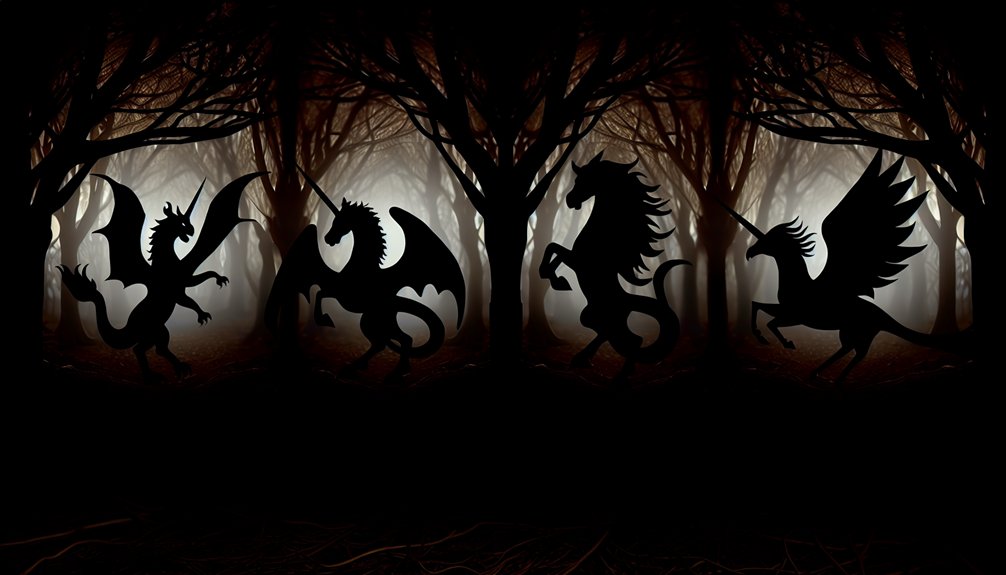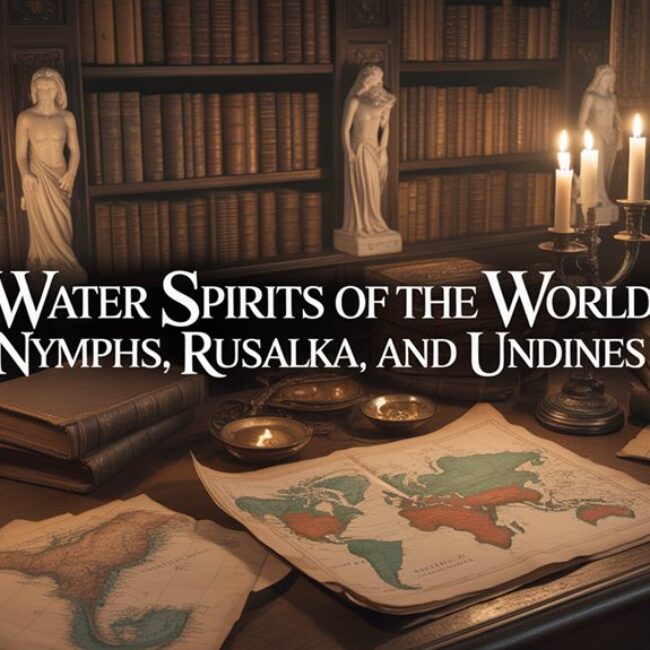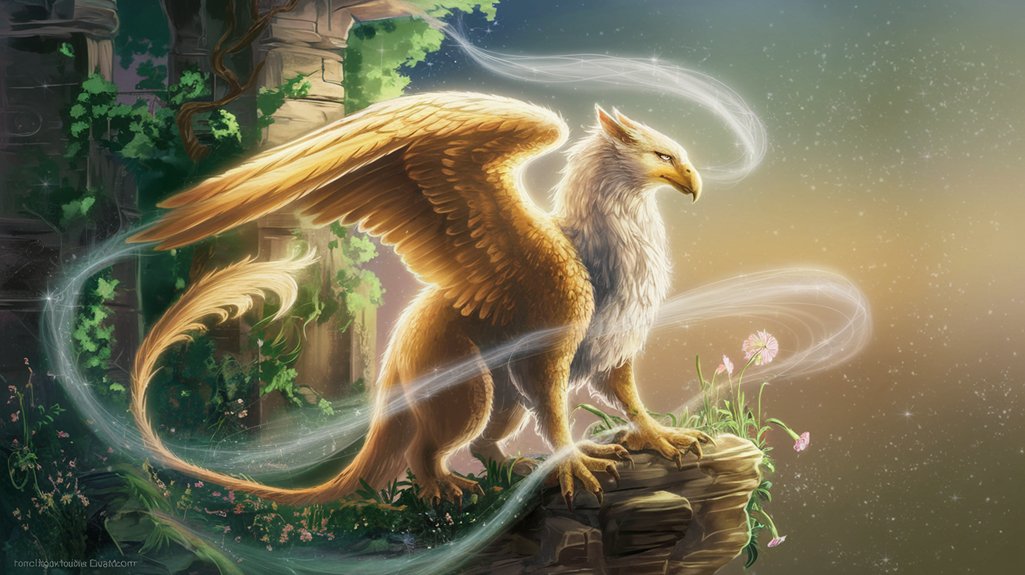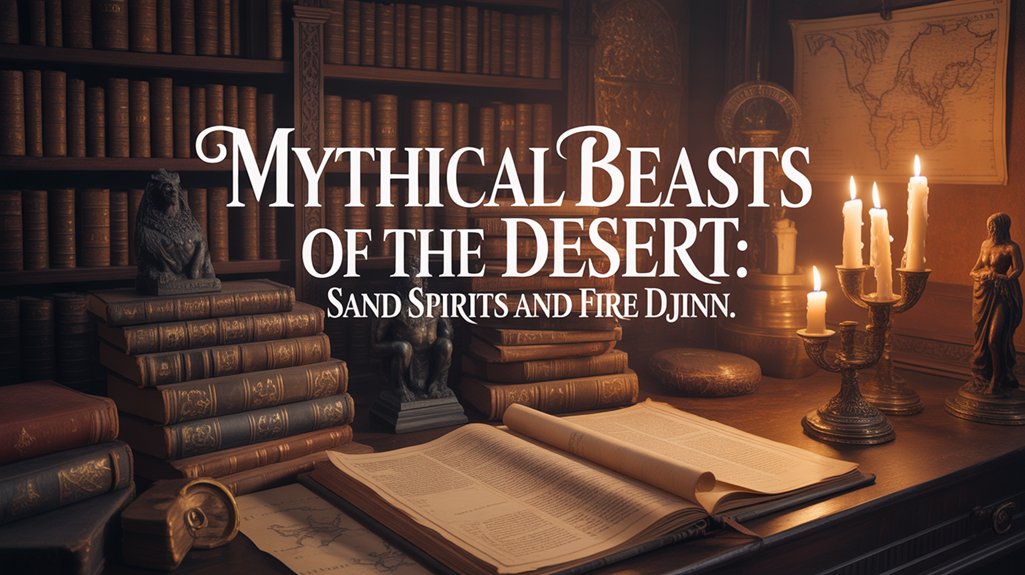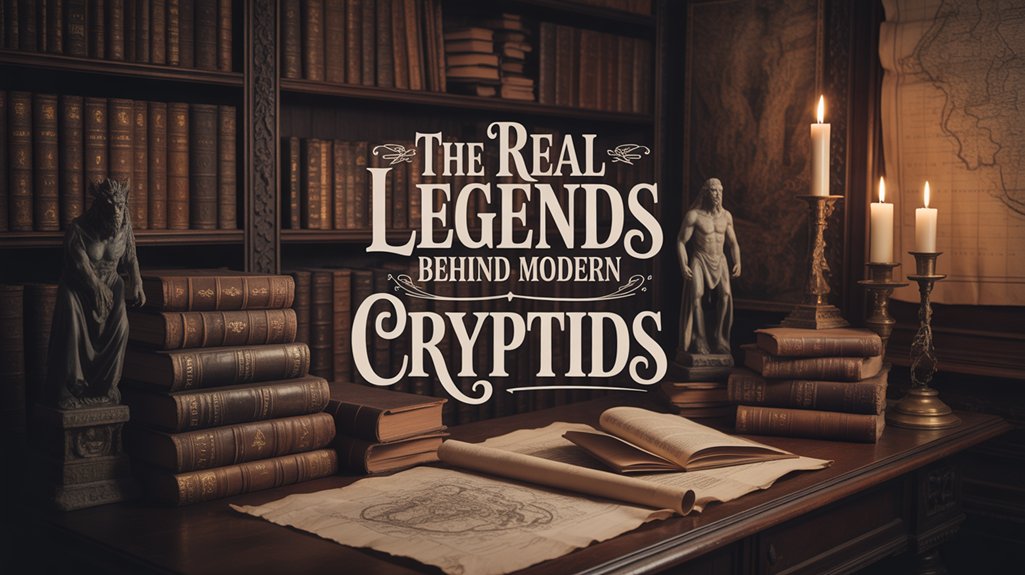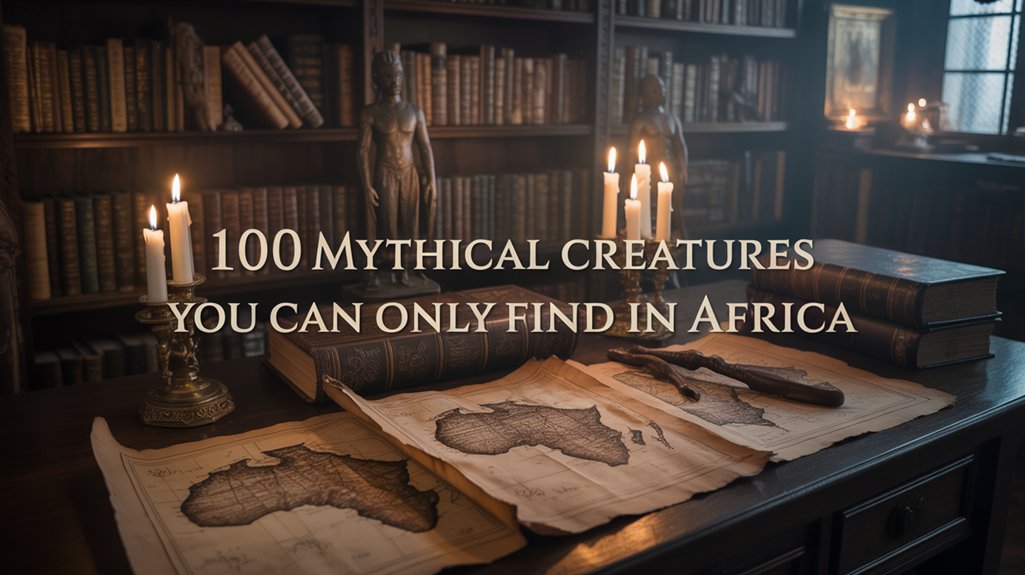
You’ll encounter guardians at death’s threshold across every civilization—chimeric sentinels whose authority transcends mortal understanding. Cerberus, the three-headed hound born from Typhon and Echidna, prevents unauthorized passage at Acheron’s gates, his serpentine heads embodying past, present, and future. Anubis weighs hearts against Ma’at’s feather in Egyptian judgment halls, while Mictlantecuhtli oversees nine treacherous levels of Aztec Mictlan. These psychopomps aren’t benevolent protectors but boundary enforcers maintaining cosmic order between existence and oblivion, their forms reflecting each culture’s deepest values about mortality’s inescapable sovereignty and what awaits beyond.
Table of Contents
ToggleKey Takeaways
- Underworld guardians like Cerberus, Anubis, and Yama maintain barriers between living and dead across different civilizations.
- Cerberus, the three-headed hound, prevents unauthorized passage at Hades’ gates, symbolizing death’s inevitability and finality.
- Anubis weighs hearts against Ma’at’s feather in Egyptian tradition, determining souls’ worthiness for the afterlife.
- Mictlantecuhtli oversees navigation through Mictlan’s nine levels in Aztec mythology, testing souls’ endurance.
- These guardians reflect cultural values—payment, judgment, honor, endurance—serving as psychological technologies for processing mortality.
Death’s Gatekeepers Across Civilizations

Across the threshold where mortal existence yields to eternal mystery, civilizations have conjured specific entities—neither wholly benevolent nor entirely malevolent—to shepherd souls through the liminal darkness between worlds.
Between life and death stand figures of shadow—not saviors, not executioners—merely silent guides through humanity’s most terrifying threshold.
You’ll find Charon demanding his obol, that copper token placed beneath your tongue before burial, his skeletal fingers gripping the ferry pole as he navigates Acheron’s black waters. In Egypt’s necropolis, Anubis—jackal-headed and eldritch—weighs your heart against Ma’at’s feather, determining worthiness.
These mythical guides manifest differently across cultures, yet serve identical functions: gatekeepers of passage.
Norse Hel reigns over Helheim’s frost-bound halls. Mictlantecuhtli’s skeletal visage presides over nine treacherous levels of Mictlan. Japan’s Shinigami guide rather than condemn, honoring death’s natural rhythm.
Such afterlife beliefs reveal humanity’s profound need to structure the unknowable, altering death’s chaos into navigable route. Each civilization constructed psychopomps reflecting their deepest values—payment, judgment, honor, endurance, respect.
These chimeric figures remain humanity’s answer to oblivion’s terror. These myths about supernatural beings explain not only origins of the cosmos but also the fundamental boundaries between life and death that define each culture’s worldview.
##
Beyond the psychopomps who shepherd souls to their final destinations, you’ll encounter the territorial guardians themselves—entities whose very forms manifest the eldritch terror of boundary enforcement.
Cerberus, that chimeric amalgamation of canine ferocity multiplied threefold, stands sentinel at Hades’ threshold, while Charon demands his obol for passage across the Styx, those five rivers whose waters separate mortal existence from eternal shadow.
Serpentine protectors coil through underworld narratives across continents, from the Mesoamerican feathered serpents guarding Xibalba’s depths to the draconic watchers of Chinese diyu, each culture manifesting its deepest anxieties about death’s permanence through these ophidian forms.
Underworld Guardians: Mythical Creatures That Rule the Afterlife
While mortals have long contemplated the nature of death, civilizations throughout history have populated their afterlife domains with formidable guardians—entities whose primary function extends far beyond mere symbolism into the essential cosmic task of maintaining the barrier between the living and the dead.
Consider Cerberus, whose chimeric form guards Hades’ threshold. The three-headed hound prevents unauthorized passage.
Egypt’s Anubis presides over afterlife rituals, his jackal visage witnessing the heart’s weighing against Ma’at’s feather.
Hindu tradition offers Yama, dharmaraja dispensing karmic justice.
Mictlantecuhtli demands treacherous navigation through Mictlan’s nine levels, testing departed souls.
Norse Hel accepts the unheroic dead without prejudice—illness, age, ordinary endings.
These mythical gatekeepers embody humanity’s recognition that death requires governance, that chaos demands order, that change necessitates threshold guardians maintaining cosmic boundaries.
Cerberus the Three-Headed Hound
At the obsidian gates where Acheron’s waters meet Styx’s mournful flow, Cerberus maintains his eternal vigil—a chimeric sentinel whose three snarling heads survey simultaneously the worlds of death and life.
You’ll find Cerberus mythology rooted in his fearsome lineage: born to Echidna and Typhon, monsters who spawned civilization’s darkest terrors. His serpentine tail coils. His mane writhes with vipers.
Each head embodies temporal dimensions—past, present, future—creating Cerberus symbolism that transcends mere guardianship. He doesn’t simply prevent escape; he enforces cosmic order, ensuring souls remain for judgment in Hades’ domain.
This eldritch hound represents humanity’s eternal truth: death’s finality can’t be negotiated, bargained, or overthrown. Like the Titans who preceded the Olympian gods, Cerberus embodies primordial forces that govern the fundamental laws of existence. Only acceptance remains.
Ferryman Charon’s River Crossing
Past Cerberus’s vigilant gaze, the newly dead encounter their second threshold—the weathered skiff of Charon, that gaunt psychopomp whose skeletal fingers have gripped his ferrying pole since humanity first conceived of death’s geography.
You’ll find him waiting at Acheron’s shores, his lantern casting eldritch shadows across waters separating existence from void.
Ancient Greeks understood: freedom in death requires transaction. Charon’s payment—that single obol placed beneath your tongue—purchases passage beyond mortal suffering into domains where earthly bondage dissolves.
Without it, you’re condemned to wander those liminal banks eternally, neither living nor properly dead. This grim economics of the afterlife reflects profound wisdom: liberation demands sacrifice, even beyond the veil.
The ferryman accepts no credit, no promises—only cold metal speaks truth.
Serpents and Dragon Protectors
Beyond Charon’s waters, coiled sentinels await—serpents whose scales gleam with otherworldly iridescence, dragons whose breath carries the scent of eternity itself.
These eldritch guardians transcend mere monster classification, embodying the liminal threshold between mortality and what lies beyond.
Serpent symbolism manifests powerfully in Egypt’s Apophis, the chaos-serpent who threatens Ra’s solar barque nightly, demanding perpetual defeat to preserve cosmic order.
Mesoamerica’s Quetzalcoatl, the feathered serpent, bridges creation and death itself. Greece’s dragon Ladon coiled eternally around sacred Hesperian apples, protecting golden immortality.
Dragon mythology reaches its apex in Chinese tradition, where dragons escort ancestral spirits through their eternal journey.
These chimeric protectors don’t merely guard—they *define* passage, their presence altering death from ending into transition.
Sacred. Absolute. Necessary.
Ancient Mesopotamian Underworld Records

You’ll find humanity’s earliest systematic records of the afterlife etched into cuneiform tablets across the Tigris-Euphrates river valleys, where Sumerian scribes committed to clay their eldritch visions of Kur—that subterranean domain beneath the cosmic waters.
These primordial texts, dating from the third millennium BCE, reveal creation myths wherein the underworld emerged as a necessary counterbalance to the world above, a shadowed mirror where Ereshkigal’s absolute sovereignty began.
The mythology wasn’t merely speculative theology but lived cosmology, inscribed with the weight of cultural memory that would influence Akkadian, Babylonian, and Assyrian conceptions of death’s territory for millennia to come.
Sumerian Underworld Creation Myths
When the ancient Sumerians contemplated the architecture of death circa 3000 BCE, they envisioned Kur—an eldritch domain of eternal twilight where the goddess Ereshkigal presided over humanity’s final congregation.
You’ll find no hierarchies here, no privileged souls escaping the shadowy existence awaiting all mortals. Sumerian mythology democratized death itself.
The descent of Inanna crystallizes this cosmic order. She surrendered her divine regalia, confronted Ereshkigal, died, and returned—embodying life’s inexorable cycles.
The Land of No Return wasn’t metaphorical. It was geography, 境界, threshold.
Your ancestors understood what we’ve forgotten: mortality binds us equally. They performed underworld rituals, made offerings to chimeric guardians, guaranteed safe passage through Kur’s territories.
Freedom meant accepting death’s sovereignty, not denying it. The Sumerians knew reverence opens gates that fear only locks tighter.
Tigris-Euphrates River Valleys
Between the twin arteries of the Tigris and Euphrates, where silt became civilization circa 4500 BCE, scribes etched humanity’s earliest cartography of death onto clay tablets that still whisper their secrets. You’ll discover that river crossings weren’t merely geographical features—they formed eldritch boundaries between territories. The Euphrates itself became the threshold, demanding tribute for passage into Ereshkigal’s domain.
| Underworld Element | Symbolic Function |
|---|---|
| River Euphrates | Boundary separating living from dead |
| Ereshkigal | Absolute sovereign of Kur’s shadows |
| Nergal | Chimeric war-death consort |
These afterlife journeys revealed Mesopotamia’s democratic death: kings and slaves alike descended into uniform darkness. The Epic of Gilgamesh preserves these visions, showing you how ancient minds mapped mortality’s terrain through sacred geography.
Earliest Written Afterlife Texts
Although humanity had voiced its terror of death through oral tradition for millennia, Mesopotamian scribes—working between 2100 and 1200 BCE—became mortality’s first cartographers, pressing reed styluses into wet clay to immortalize what lay beyond the veil.
You’ll find their eldritch wisdom preserved in the *Epic of Gilgamesh*, where Enkidu’s shade reveals Kur’s bitter truth: a lightless territory where kings feast on dust alongside slaves. The goddess Ereshkigal presides over this chimeric domain, her divine authority absolute.
*The Descent of Inanna* chronicles an even darker journey—seven gates stripping power from flesh, death preceding rebirth.
These Mesopotamian underworld texts established afterlife beliefs that would echo through civilizations: that death equalizes all mortals, that divine guardians judge souls, that ritual offerings purchase favor in shadow-lands beyond mortal comprehension.
Greek Three-Headed Cerberus Guardian

In the shadowed vestibule where mortal domain meets eternal darkness stands Cerberus, the eldritch sentinel whose three slavering heads maintain the Underworld’s inexorable boundary. This chimeric beast embodies Underworld symbolism through its very anatomy—serpentine tail writhing, mane of vipers hissing warnings to those who’d transgress death’s immutable laws.
| Temporal Head | Symbolic Domain | Guardian Function |
|---|---|---|
| Past | Memory of death | Judges souls’ histories |
| Present | Current mortality | Blocks living entrance |
| Future | Eternal finality | Prevents escape |
Cerberus mythology reaches its apex when Heracles, strength incarnate, subdued this three-headed warden barehanded—the Twelfth Labor proving mortal capability against divine prohibition. You’ll find no creature more emblematic of death’s sovereignty. Each snarling maw enforces separation between worlds, ensuring the deceased remain confined while the living maintain respectful distance. This guardian doesn’t merely patrol boundaries; he *is* the boundary, flesh made philosophical principle.
Three Heads Represent Time’s Divisions
- Each head witnesses different phases of mortal existence—birth’s emergence, life’s unfolding, death’s inevitable arrival.
- The creature’s tripartite consciousness mirrors Hades’s own dominion over souls’ past histories, present judgments, and future placements.
- Multiple-headed guardians across cultures consistently embody control over fate’s temporal mechanisms.
- Time’s divisions become physically manifest, altering abstract chronology into eldritch flesh.
This architectural marvel alters the underworld gates into something more sophisticated than mere barrier.
They become temporal nexus. The three heads don’t watch separately—they weave time’s threads together, ensuring mortality’s cycle remains unbroken, inevitable, absolute.
Heracles’ Twelfth Labor Capture
You’ll find that Heracles’ final labor—the capture of Cerberus, that chimeric sentinel whose three serpent-crowned heads embodied the inescapable threshold between mortal life and eldritch eternity—demanded not merely physical prowess but a willingness to transgress the most sacred boundary in Greek cosmology.
The hero’s descent into Hades’ chthonic domain required permission from the god of the dead himself, a negotiation that altered this labor from simple beast-hunting into a profound confrontation with mortality’s absolute dominion.
Most remarkably, Heracles subdued the guardian without lethal weapons, binding the creature through raw strength alone, thereby proving that courage and divine favor could temporally overcome even death’s most formidable watchman.
Cerberus: Three-Headed Guardian
The monstrous sentinel known as Cerberus—κέρβερος in the ancient Greek—stands as perhaps the most formidable threshold guardian in all of Mediterranean mythology, a chimeric hound whose three ravenous heads perpetually scan the shadowed shores of the river Styx.
You’ll discover that Cerberus symbolism operates on multiple temporal planes: his triune nature embodying past, present, and future manifestations of mortality itself. His serpentine tail writhes with eldritch purpose, while vipers coil through his mane, creating an impenetrable barrier between worlds.
Mythological interpretations reveal his dual function—preventing living souls from breaching the underworld’s veil while ensuring the dead remain eternally bound.
When Heracles descended to claim him, the hero eschewed weaponry entirely, relying solely on raw strength and cunning to subdue this infernal gatekeeper and momentarily liberate him from Hades’ domain.
Descent Into Hades’ Realm
When Eurystheus commanded his final and most perilous labor, Heracles confronted not merely another beast to be slain but the ultimate boundary itself—the threshold between mortal existence and eternal shadow.
You witness here Hades’ symbolism manifest: death’s sovereignty, inviolable and absolute. The hero descended weaponless, bound by divine covenant with the underworld’s sovereign, traversing eldritch pathways where shades whispered of humanity’s inevitable terminus.
Ancient afterlife perceptions crystallized in this descent—mortality wasn’t escapable through strength alone. Heracles grappled Cerberus with bare hands, subduing the chimeric guardian through will transcending physical prowess.
This labor demanded confrontation with what all mortals fear: oblivion’s approach, darkness unconquerable. Yet he emerged victorious, beast in tow, demonstrating that courage—not weapons—conquers death’s dominion.
Freedom lies in accepting mortality’s challenge directly.
Capture Without Deadly Weapons
Before profaning death’s sovereignty with bronze or iron, Heracles stood bound by sacred oath—a covenant demanding restraint where violence had previously proven his currency.
Hades’ stipulation altered the labor into something unprecedented: a non violent capture requiring mythical strength channeled through discipline rather than destruction.
You witness the hero descending into chthonic depths, his hands weaponless yet terrible in their power. The eldritch guardian Cerberus—three slavering heads, serpentine tail coiling through sulfurous air—met not slaughter but submission.
Through sheer wrestling prowess, Heracles throttled the beast into compliance, demonstrating that true freedom comes through mastery of self before mastery of others.
This restraint honored death’s domain while proving strength transcends mere carnage. The hero ascended victorious, Cerberus leashed by will alone.
Cerberus in Harry Potter Films
J.K. Rowling reimagined Cerberus through Fluffy, altering the ancient psychopomp into a chimeric sentinel guarding Hogwarts’s subterranean mysteries. This three-headed beast embodies the eldritch terror of its mythological predecessor, stationed above a trapdoor leading to domains of forbidden knowledge—a modern underworld threshold challenging young wizards to confront mortality’s vestibule.
Fluffy’s Guardianship of Hidden Domains:
- Three heads manifesting synchronized aggression, each cranium capable of independent vocalization, creating cacophonous warnings that mirror Hesiod’s original descriptions from 700 BCE.
- Music’s impact revealing ancient soothing techniques, whereby harp melodies induce slumber, echoing Orphic traditions of lyre-playing to bypass infernal guardians.
- Fluffy’s role as threshold protector, positioning him between mortal students and alchemical secrets beneath the castle’s foundations.
- The Philosopher’s Stone connection, linking immortality pursuits with afterlife mythology’s fundamental concerns.
This cinematic interpretation preserves Cerberus’s essential function while liberating the archetype from purely Greco-Roman constraints.
It demonstrates how mythological guardians transcend temporal boundaries, adapting across civilizations yet maintaining their primal purpose.
Jung’s Archetypal Death Symbolism
Carl Gustav Jung’s analytical psychology changed death from mere biological cessation into a numinous threshold where consciousness confronts its own dissolution and potential rebirth.
You’ll discover within his framework that death alteration operates as psychological alchemy, transmuting fear into wisdom through archetypal engagement. The eldritch symbols populating your dreams—skeletal sentinels, descending passages, liminal gateways—aren’t mere phantasms but emissaries from the unconscious, demanding shadow acceptance.
Jung recognized that mythological psychopomps, those chimeric guides traversing between worlds, mirror your own psyche’s confrontation with annihilation. When you integrate death awareness, you’re not surrendering to morbidity but claiming authentic existence.
Death awareness through archetypal guides transforms existential terror into radical authenticity, liberating consciousness from collective immortality delusions.
The Shadow archetype, cloaked in mortuary imagery, whispers of repressed truths requiring acknowledgment. This individuation process liberates you from collective delusions of immortality.
Through consciously engaging death symbols—whether Charon’s oar, Anubis’s scales, or Cerberus’s triple gaze—you reshape existential dread into profound meaning, discovering that mortality’s acceptance paradoxically intensifies life’s luminous immediacy.
Contemporary Death Anxiety Understanding
While modernity’s technological triumph promises mastery over nature, it simultaneously divorces you from mortality’s ancient rituals, creating what Becker termed “the denial of death”—a collective psychosis that paradoxically intensifies the very terror it seeks to suppress.
Your contemporary dread manifests physiologically: racing hearts, insomnia, phantom pains—somatic echoes of unspoken fears.
Yet existential reflection offers liberation. When you engage mortality directly through contemplative practices, dialogue circles, or ceremonial acknowledgment, death anxiety diminishes remarkably.
The ancient death deities—Anubis, Hel, Yama—weren’t merely chimeric horrors but psychological technologies for processing inevitable dissolution. Their eldritch iconography provided containers for terror, altering raw panic into sacred awe.
You need similar frameworks now. Death acceptance emerges not through avoidance but confrontation, reclaiming mortality from societal taboo.
The underworld guardians understood: freedom lives in acknowledgment, not denial. Face the abyss consciously, and its power changes from enemy to teacher.
Eternal Guardians’ Cultural Legacy
Across civilizations separated by vast oceans and millennia, humanity constructed remarkably parallel architectures of death—guardian figures whose eldritch forms weren’t arbitrary monstrosities but sophisticated cultural technologies for managing existential crisis.
You’ll find this cultural significance embedded within every civilization’s approach: Cerberus’s three heads scanning temporal dimensions, Anubis’s jackal visage weighing hearts against feathers, Mictlantecuhtli’s skeletal grin presiding over Mictlan’s inevitable descent. These weren’t mere symbols. They were psychological infrastructures.
Consider how mythological interpretations evolved alongside societal needs. Norse Hel distinguished between ordinary death and warrior glory, codifying cultural values through afterlife topography.
Japan’s Shinigami reframed mortality as natural passage rather than punishment. Baron Samedi and Maman Brigitte changed Haitian suffering into sacred theater, death becoming celebration rather than tragedy.
You’re witnessing humanity’s greatest cognitive achievement: transmuting terror into meaning through chimeric forms that bridge consciousness and void.
These eternal guardians remain active, their cultural legacy pulsing through contemporary death anxiety.
Frequently Asked Questions
Do All Cultures Believe in Punishment for Souls in the Afterlife?
You’ll find afterlife beliefs vary dramatically across cultures—not all embrace soul punishment.
Ancient Egyptian traditions focused on Ma’at’s scales of justice, while certain Buddhist philosophies emphasize karmic cycles without eternal damnation.
Indigenous Australian Dreamtime cosmologies, Chinese ancestor veneration, and pre-Christian Norse traditions often rejected punitive underworlds entirely.
You’re witnessing humanity’s eldritch diversity: some cultures envisioned transcendence, metamorphosis, or peaceful ancestral domains rather than torment.
Freedom from punishment wasn’t universal, yet it existed.
What Happens to Pets When They Die According to Different Mythologies?
You’ll find pet afterlife varies dramatically across traditions.
Ancient Egyptian animal spirits journeyed through the Duat alongside humans—cats particularly revered.
Norse Fólkvangr welcomed warriors’ horses, hounds bound to their masters eternally.
Indigenous American beliefs honor animal spirits as guides, returning to the great cycle.
Some cultures dismissed pets entirely from afterlife domains.
Others, like certain Buddhist traditions, recognized transmigration—your beloved companion potentially reborn, consciousness flowing through samsara’s endless wheel, seeking liberation.
Can Living People Communicate With Underworld Guardians Through Rituals?
You’ve always possessed the capacity for spirit communication with chthonic guardians through consecrated practice.
Ancient Greeks performed nekyia—blood offerings poured into trenches—while Tibetan chöd practitioners dismembered their consciousness to meet Yama’s attendants.
The ritual significance lies in liminality: dawn, dusk, crossroads, caves.
You’ll need offerings specific to each tradition—honey for Hecate, jade for Yanluo Wang.
These aren’t superstitions but eldritch technologies, pathways your ancestors mapped through centuries of systematic boundary-crossing.
Are There Female Guardians of the Underworld in World Mythology?
Like shadows cast across ancient temple stones, female deities have commanded the underworld’s depths throughout world mythology.
You’ll discover Ereshkigal ruling Mesopotamia’s dark domain, Hel presiding over Norse dead, and Persephone wielding dual sovereignty over Greek chthonic passages.
Underworld symbolism intertwines with feminine power—birth, death, regeneration.
These goddesses weren’t gentle shepherds but eldritch sovereigns: Mictēcacihuātl governing Aztec skeletal domains, Sedna dwelling in Arctic ocean depths.
They’ve embodied alteration’s terrible necessity, rejecting patriarchal constraints through their fearsome autonomy.
How Do Modern Religions View Ancient Underworld Guardian Myths Today?
You’ll find modern religions approach ancient beliefs through dual lenses: dismissal as superseded paganism, or incorporation as archetypal wisdom.
Abrahamic faiths often recast chimeric guardians—Cerberus, Ammit, the Mesopotamian galla—as demons or symbolic allegories.
Yet modern interpretations reveal deeper respect among scholars and practitioners. They’re recognizing these eldritch sentinels as humanity’s profound meditation on mortality, justice, change.
You’re witnessing resurrection of ancestral knowledge, where ancient psychopomps transcend dogma, becoming universal symbols of threshold consciousness.
Conclusion
You’ve journeyed through domains where Cerberus guards Hades’ gates, where Mesopotamian demons clutch clay tablets, where chimeric sentinels stand eternal. These eldritch guardians aren’t mere mythology—they’re humanity’s attempt to comprehend death’s threshold, to name the unnameable. You’ll find them in ancient texts and modern cinema, in Jung’s archetypes and your own nocturnal anxieties. They persist because you need them: gatekeepers who change terror into reverence, chaos into order, oblivion into passage.






